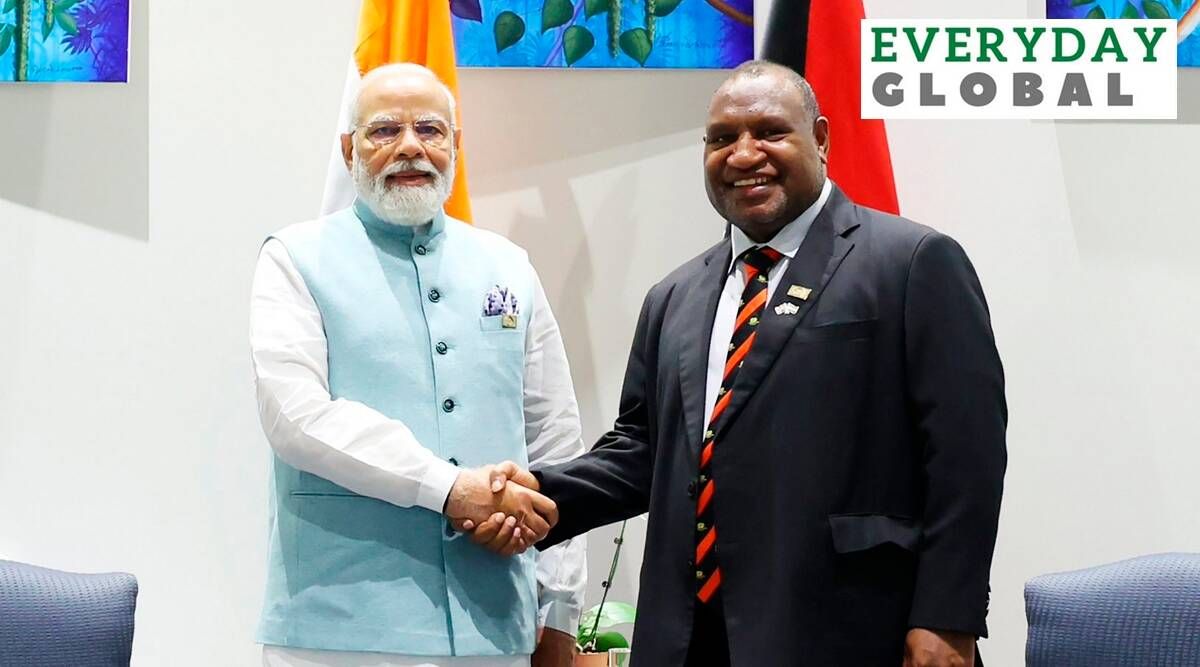Papua New Guinea’s PM touches Modi’s feet: Why this island country is important for India
In what is being seen as an oblique reference to China, Prime Minister Narendra Modi Monday told leaders of 14 Pacific Island nations on Monday that India would be a “reliable” development partner, even though those considered trustworthy were “not standing by our sides in times of need”.
Speaking at the Forum for India-Pacific Islands Cooperation (FIPIC) summit in Port Moresby, Papua New Guinea, Modi said, “Those we considered trustworthy, it turned out they were not standing by our side in times of need. During these challenging times, an old saying has proven true: ‘A Friend in need is a friend indeed’. I am glad that India stood with its Pacific island friends during this challenging time [the Covid pandemic]. Whether it was vaccines or essential medicines, wheat or sugar; India, in line with its capabilities, has been assisting all partner countries,” reported PTI.
Earlier on Sunday, Papua New Guinea Prime Minister James Marape, while welcoming PM Modi, bent down to touch his feet, in a move that attracted significant attention. Modi is the first Indian PM to visit the country. PTI reported that normally, Papua New Guinea doesn’t give a ceremonial welcome to any leader coming after sunset, but an exception was made for Modi.
Why is Papua New Guinea important for India?
Strategic location
Papua New Guinea is located north of Australia, a region where China is trying to expand its influence and Australia and the US are seeking to counter it. China has made large investments in Papua New Guinea, funding infrastructure and schools, in what many believe is an attempt to gain military and diplomatic leverage. Last year, China signed a security pact with Solomon Islands, located in the same region. On Monday, the US and Papua New Guinea signed a security agreement, prompting protests from island residents who oppose ‘militarisation’ of the Pacific.
India is also trying to boost ties and cooperation with the Pacific Island nations, which include, apart from Papua New Guinea and Solomon Islands, Cook Islands, Fiji, Kiribati, the Republic of Marshall Islands, Micronesia, Nauru, Niue, Palau, Samoa, Tonga, Tuvalu and Vanuatu.
The FIPIC summit and PM Modi’s recent visit to Fiji and Papua New Guinea was in line with that. The FIPIC summit was launched during Modi’s visit to Fiji in 2014. In 2015, the second FIPIC summit was held in Jaipur. This is the third summit.
Population, economy
Papua New Guinea is the world’s third largest island nation, a lower middle-income country with a predominantly rural population. It is lingustically one of the most diverse nations of then world, with more than 800 languages spoken.
Advertisement
It has a population of 9,819,350, according to an estimate by CIA’s The World Factbook. Many indigenous communities live in Papua New Guinea, surviving on subsistence agriculture and keeping little contact with the outside world.
Since the 1880s, parts of the country have been ruled by Germany, Australia, and Britain, till the independent nation was born on September 16, 1975.
Also Read | How a Kenyan starvation cult led to the deaths of more than 200 people
According to the World Factbook, “the word “papua” derives from the Malay “papuah” describing the frizzy hair of the Melanesians; Spanish explorer Ynigo ORTIZ de RETEZ applied the term “Nueva Guinea” to the island of New Guinea in 1545 after noting the resemblance of the locals to the peoples of the Guinea coast of Africa.”
Government
Advertisement
Papua New Guinea is part of the Commonwealth, and England’s King Charles III is its official King. The monarch is represented by the Governor-General, who is nominated by the Parliament. The Prime Minister is democratically elected. While James Marape is the current Prime Minister, the Governor-General is Bob Dadae, whom PM Modi also met on his recent visit.
Source: The Indian Express


